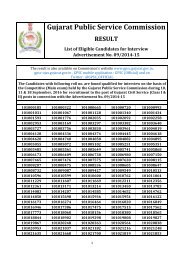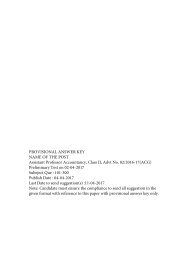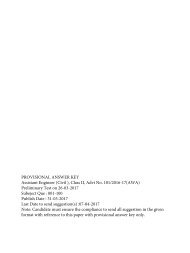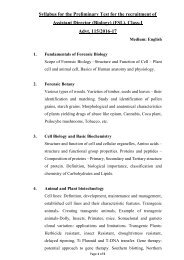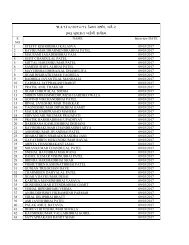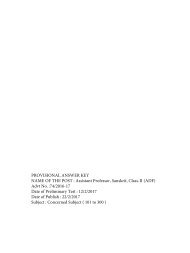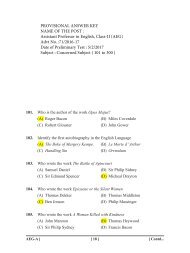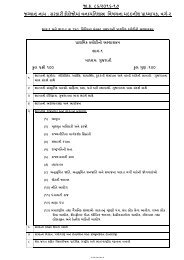1RTT9YT_84-201516
1RTT9YT_84-201516
1RTT9YT_84-201516
Create successful ePaper yourself
Turn your PDF publications into a flip-book with our unique Google optimized e-Paper software.
PROVISIONAL ANSWER KEY<br />
NAME OF THE POST: Assistant Professor,Industrial Engineering, Class II,(ALP-A)<br />
(Advt. No. : <strong>84</strong>/2015-16)<br />
DATE OF PRELIMINARY TEST : 18-03-2017<br />
SUBJECT : Concerned Subject (Que. 101-200)<br />
Date of Publish : 27/03/2017<br />
Last Date to send Suggestion(s) : 03-04-2017<br />
Note : Candidate must ensure the complaince to send all suggestion in the given<br />
format with reference to this paper with provisional answer key only. Any non<br />
compliance shall not be treated.<br />
101. The probability that a product will operate properly within an expected time<br />
frame is the dimension of quality known as<br />
(A) durability<br />
(B) reliability<br />
(C) performance<br />
(D) serviceability<br />
102. Which of the following quality tools display major causes of poor quality on<br />
a graph?<br />
(A) Process flow chart<br />
(B) Fishbone diagram<br />
(C) Histogram<br />
(D) Scatter diagram<br />
ALP-A ] [ 16 ] [ Contd...
103. Which of the following is NOT a primary purpose of statistical process<br />
control?<br />
(A) to establish control limits<br />
(B) to detect special cause variations<br />
(C) to identify specification limits<br />
(D) to determine when a process is not in control<br />
104. If a sample of 40 units of output found 500 defects, then the 3-sigma upper<br />
control limit for the c chart would be<br />
(A) 12.5 (B) 23.11<br />
(C) 37.5 (D) 75.0<br />
105. The probability of rejecting a lot that has an acceptable quality level is<br />
referred to as the<br />
(A) producer’s risk<br />
(B) consumer’s risk.<br />
(C) lot tolerance percent defective (D) acceptable quality level.<br />
106. A(n) _______ curve is a graph showing the probability of accepting a lot for<br />
different quality levels with a specific sampling plan.<br />
(A) operating characteristic (OC) (B) average outgoing quality<br />
(C) lot tolerance percent defective (D) single-sample attribute<br />
107. The expected number of defective items that will pa on to the customer with<br />
a sampling plan is known as the<br />
(A) lot tolerance percent defective. (B) acceptable quality level.<br />
(C) average outgoing quality. (D) sampling plan.<br />
108. All of the following can improve a product’s reliability except<br />
(A) simplifying product design<br />
(B) improving individual component reliability<br />
(C) changing the product warranty<br />
(D) adding redundant components<br />
109. A structured process that translates the voice of the customer into technical<br />
design requirements is known as<br />
(A) quality function deployment (QFD)<br />
(B) failure mode and effects analysis (FMEA)<br />
(C) concurrent design<br />
(D) robust product design<br />
ALP-A ] [ 17 ] [ P.T.O.
110. A company produces a product consisting of two components arranged as<br />
follows:<br />
0.95 0.93<br />
If both components must function for the product to function, then the<br />
product’s overall reliability is<br />
(A) 0.950 (B) 0.940<br />
(C) 0.930 (D) 0.8<strong>84</strong><br />
111. Which of the following will not improve design for manufacture and<br />
assembly?<br />
(A) Minimizing the number of parts and subassemblies.<br />
(B) using standard parts when possible<br />
(C) designing parts for limited, unique uses<br />
(D) designing parts for many, varied uses<br />
112. The number of arrivals per unit of time at a service facility can frequently be<br />
described by a<br />
(A) normal distribution.<br />
(B) Poisson distribution.<br />
(C) binomial distribution. (D) beta distribution.<br />
113. Consider an espresso stand with a single server. Customers arrive to the stand<br />
at the rate of 28 per hour according to a Poisson distribution. Service times<br />
are exponentially distributed with a service rate of 35 customers per hour.<br />
The probability that there are more than 2 customers in the system is<br />
(A) 0.128 (B) 0.488<br />
(C) 0.512 (D) 0.640<br />
114. A company is evaluating which of two alternatives should be used to produce<br />
a product that will sell for $35.00 per unit. The following cost information<br />
describes the two alternatives<br />
Process A Process B<br />
Fixed Cost Rs.500,000 Rs. 750,000<br />
Variable Cost per Unit Rs. 25.00 Rs. 23.00<br />
If total demand (volume) is 120.000 units, then the company should<br />
(A) select Process A with a profit of Rs. 940.000 to maximize profit<br />
(B) select Process B with a profit of Rs. 450,000 to maximize profit<br />
(C) select Process A with a profit of Rs. 700,000 to maximize profit<br />
(D) select Process B with a profit of Rs. 690,000 to maximize profit<br />
ALP-A ] [ 18 ] [ Contd...
115. Steel, paper, paints, and chemicals are examples of products that use<br />
(A) batch production<br />
(B) repetitive production.<br />
(C) continuous production (D) ma production.<br />
116. Which of the following describes a Process layout?<br />
(A) equipment is general purpose and the workers are unskilled<br />
(B) equipment is specialized and the workers are highly skilled<br />
(C) equipment is general purpose and the workers are highly skilled<br />
(D) equipment is specialized and the workers are unskilled<br />
117. Two techniques used to design process layouts are<br />
(A) block diagramming and assembly line balancing.<br />
(B) relationship diagramming and assembling line balancing.<br />
(C) relationship diagramming and assembly line balancing.<br />
(D) block diagramming and relationship diagramming.<br />
118. An assembly line consists of three workstations (WS) with each station’s<br />
activity time as shown.<br />
WS 1(5 min) WS 2 (3 min) WS 3 (4 min)<br />
The cycle time for this line is<br />
(A) 5 minutes<br />
(C) 4 minutes<br />
(B) 3 minutes<br />
(D) 12 minutes<br />
119. Which of the following statements is most true?<br />
(A) product layouts are flexible; process layouts are efficient<br />
(B) product layouts are efficient: process layouts are flexible<br />
(C) product and process layouts are equally flexible; neither are efficient<br />
(D) product and process layout are equally efficient: neither are flexible<br />
120. One of the best known computerized packages available for designing<br />
process layouts is CRAFT. CRAFT stands for<br />
(A) computerized relationship activity and flow technique.<br />
(B) computerized relative allocation of facilities technique.<br />
(C) computerized relative assembly and flow technology.<br />
(D) computerized relationship assembly flow time.<br />
ALP-A ] [ 19 ] [ P.T.O.
l21. A company is deciding where to locate a new warehouse that will receive<br />
shipments from three suppliers: 1, 2, and 3. The locations of the suppliers<br />
(x 1,<br />
y 1<br />
) and the annual number of shipments from supplier i (W i<br />
) are provided<br />
below:<br />
1 2 3<br />
x 1<br />
= 250 x 2<br />
= 100 x 3<br />
= 500<br />
y 1<br />
= 250 y 2<br />
= 400 y 3<br />
= 300<br />
W, = 240 W 2<br />
= 205 W 3<br />
= 300<br />
The coordinates for the new warehouse suggested by the center of gravity<br />
method are<br />
(A) x = 311.4 and y = 309.4 (B) x = 309.4 and y = 311.4<br />
(C) x = 291.2 and y =198.9 (D) x = 193.2 and y = 219.4<br />
122. Motion study, the study of the individual human motions used in a task, was<br />
developed by<br />
(A) Henry Ford<br />
(B) F. W. Taylor<br />
(C) Frank and Lillian Gilbreth (D) Frederick Herzberg<br />
123. A 90% learning curve indicates<br />
(A) a 90% increase in processing time per unit as output doubles.<br />
(B) a 90% decrease in processing time per unit as output doubles.<br />
(C) a 10% increase in processing time per unit as output doubles.<br />
(D) a 10% decrease in processing time per unit as output doubles.<br />
124. As part of its quality-improvement program a company is conducting a time<br />
study for a particular job. The time study encompassed 10 job cycles, and<br />
the results include the following cumulative times and performance rating<br />
factors for each element.<br />
Element t (min) RF<br />
1 3.33 1.10<br />
2 4.5 1.00<br />
3 2.85 1.05<br />
4 5.05 1.10<br />
5 1.53 0.90<br />
The standard time for this job using an allowance factor of 16% is:<br />
(A) 1.809 minutes<br />
(B) 2.098 minutes<br />
(C) 1.530 minutes<br />
(D) 2.233 minutes<br />
ALP-A ] [ 20 ] [ Contd...
125. How many cycles should be used in a time study in order to be 95% confident<br />
that the time-study average job cycle time is within 5% of the true average<br />
job cycle time. Assume that the average job cycle time was 2.67 minutes and<br />
the standard deviation of the sample was 0.72 minutes.<br />
(A) 36 cycles<br />
(B) 72 cycles<br />
(C) 98 cycles<br />
(D) 112 cycles<br />
126. The estimated mean time for an activity with a most likely time (m) equal to<br />
11 days, the optimistic time (a) equal to 6 days, and the pessimistic time (b)<br />
equal to 18 days is<br />
(A) 9.67 days<br />
(B) 11 days<br />
(C) 11.33 days.<br />
(D) 11.67 days.<br />
127. A project consists of the following four activities with activity times in days:<br />
Activity Predecessor Time<br />
A 6<br />
B A 5<br />
C A 4<br />
D B,C 8<br />
Using Table, the earliest finish (EF) time for activity C is<br />
(A) 4 days<br />
(B) 6 days<br />
(C) 10 days<br />
(D) 11 days<br />
128. Which of the following statements is generally true regarding the relationship<br />
between project crashing costs and indirect costs?<br />
(A) both crashing costs and indirect costs are highest when the project is<br />
shortened<br />
(B) only indirect costs increase when the project is shortened<br />
(C) both are unaffected by the length of the project<br />
(D) crashing costs increase when the project is shortened while indirect costs<br />
decrease when the project is shortened<br />
129. One way to reduce the bullwhip effect is for supply chain members to<br />
(A) make ordering decisions independently of each other.<br />
(B) create demand forecasts independently of other supply chain members.<br />
(C) share demand forecasts with other supply chain members.<br />
(D) restrict information flows between supply chain members.<br />
ALP-A ] [ 21 ] [ P.T.O.
130. A company that produces small electric motors for treadmills had cost of<br />
goods sold last year of Rs. 241.000.000. The average value of inventory for<br />
raw materials, work-in-process, and finished goods are shown in the table<br />
below:<br />
Raw Materials Rs. 12,379.000<br />
Work-In-Process Rs. 7.631,000<br />
Finished Goods Rs. 9.275,000<br />
If the company operates 365 days a year the days of supply being held in<br />
inventory is<br />
(A) 44.35 (B) 27.39<br />
(C) 8.23 (D) 1215<br />
131. The fraction of orders filled by a distribution center or warehouse within a<br />
specific time period is referred to as the<br />
(A) inventory turnover<br />
(B) inventory supply time<br />
(C) fill rate<br />
(D) aggregate orders proceed<br />
132. A qualitative procedure used to develop a consensus forecast is known as<br />
(A) exponential smoothing (B) regression methods.<br />
(C) the Delphi technique<br />
(D) naive forecasting.<br />
133. An exponential smoothing forecasting technique requires all of the following<br />
except<br />
(A) the forecast for the current period.<br />
(B) the actual demand for the current period.<br />
(C) a smoothing constant.<br />
(D) large amounts of historical demand data.<br />
134. A company wants to product a weighted moving average forecast for April<br />
with the weights 0.40, 0.35. and 0.25 assigned to March. February, and<br />
January, respectively. If the company had demands of 5,000 in January. 4.750<br />
in February, and 5.200 in March, then April’s forecast is<br />
(A) 4983.33 (B) 4992.50<br />
(C) 4962.50 (D) 5000.00<br />
135. A tracking signal is computed by<br />
(A) multiplying the cumulative error by MAD<br />
(B) multiplying the absolute error by MAD<br />
(C) dividing MAD by the cumulative absolute error<br />
(D) dividing the cumulative error by MAD<br />
ALP-A ] [ 22 ] [ Contd...
136. In general, as the order size increases<br />
(A) ordering costs decrease and carrying costs increase.<br />
(B) ordering costs increase and carrying costs decrease.<br />
(C) both ordering and carrying costs increase.<br />
(D) both ordering and carrying costs decrease.<br />
137. A service level of 95% means there is a 0.95 probability<br />
(A) of meeting all demand<br />
(B) of a stockout.<br />
(C) that supply will exceed demand.<br />
(D) that demand will be met during the lead time.<br />
138. A product’s usage is normally distributed with a weekly average demand<br />
of 2.000 units and a weekly standard deviation of 125. The product’s lead<br />
time is 4 weeks. Currently, the reorder point for this product is 8,200. If the<br />
company would like to have a service level of 95% for this product then<br />
(A) it must decrease its safety stock by approximately 412 units.<br />
(B) it must decrease its safety stock by approximately 212 units.<br />
(C) it must increase its safety stock by approximately 412 units.<br />
(D) it must increase its safety stock by approximately 212 units.<br />
139. Inventory management includes all the following activities except determining<br />
(A) the amount of inventory to keep in stock.<br />
(B) customer demand .<br />
(C) how much to order.<br />
(D) when to order.<br />
140. A continuous inventory system is also known as a<br />
(A) fixed-time period system<br />
(B) fixed-order quantity system<br />
(C) fixed-lead time system<br />
(D) fixed-amount system<br />
141. The economic order quantity is most widely used for determining how much<br />
to order in<br />
(A) periodic inventory system (B) continuous inventory system<br />
(C) an on-demand inventory system (D) none of the above<br />
142. Adjusting available capacity by hiring and firing workers to match demand is<br />
an example of a(n)_________strategy.<br />
(A) level production<br />
(B) chase demand<br />
(C) mixed production<br />
(D) optimal production<br />
ALP-A ] [ 23 ] [ P.T.O.
143. The following information relates to a company's aggregate production<br />
planning activities:<br />
Quarter Demand Forecast<br />
1 75,000<br />
2 100,000<br />
3 75,000<br />
4 125.000<br />
Beginning Workforce = 35 workers<br />
Production per Employee = 1.250 units per quarter<br />
Hiring Cost = Rs. 500 per worker<br />
Firing Cost = Rs. 1.000 per worker<br />
Inventory Carrying Cost = Rs. 20 per unit per quarter<br />
If a level production strategy is used then the required quarterly output is<br />
(A) 75.000 (B) 87.350<br />
(C) 93,750 (D) 125,000<br />
144. A company is developing a linear programming model for its aggregate<br />
production plan. If I t<br />
= units in inventory at the end of period t, P t<br />
= units<br />
produced in period t. and D t<br />
= demand in period t. then the company’s demand<br />
constraint to ensure that demand is met in quarter 3 is<br />
(A) D 3<br />
= I 2<br />
– I 3<br />
+ P 3<br />
(B) D 3<br />
= I 3<br />
+ P 3<br />
(C) D 3<br />
= I 3<br />
– I 2<br />
+ P 3<br />
(D) D 3<br />
= I 2<br />
– I 3<br />
+ P 2<br />
145. Given the information below, the number of available-to-promise units in<br />
period 4 is<br />
Period<br />
On Hand = 200 1 2 3 4 5 6<br />
Forecast 300 250 300 300 200 200<br />
Customer Orders 250 200 250 200 150 250<br />
Master Production Schedule 500 700<br />
Available-to-Promise<br />
(A) 500 (B) 100<br />
(C) 200 (D) 350<br />
146. The optimal solution for a linear programming problem will always occur<br />
(A) when the slack price equals the surplus price.<br />
(B) when the surplus price equals the slack price.<br />
(C) at an extreme point.<br />
(D) at a non-extreme point.<br />
ALP-A ] [ 24 ] [ Contd...
147. For a less than or equal to (
153. Given the following MRP matrix for Item D:<br />
ITEM: D<br />
Period<br />
Lot Size: Min 100<br />
1 2 3 4 5 6 7<br />
LT: 2<br />
Gross Requirements 60 90 150 150 180 270 120<br />
Schedule Receipts 150<br />
Project on Hand<br />
120<br />
Net Requirements<br />
Planned Order<br />
Receipts<br />
Planned Order<br />
Releases<br />
The planned order release for period 3 would be<br />
(A) 100 (B) 160<br />
(C) 270 (D) 300<br />
154. The instrument used for the measurement of pressure is<br />
(A) Bellows<br />
(B) Diaphragms<br />
(C) Fiber optic pressure sensors (D) All of these<br />
155. The range of values of p and q which will render the payoff element a 22<br />
as<br />
saddle point for the game whose payoff matrix (a ij<br />
) is given below:<br />
Player A<br />
Player B<br />
2 4 5<br />
10 7 q<br />
4 P 6<br />
(A) p > = 7 and q < 7 (B) p < = 7 and q > 7<br />
(C) p > 7 and q < = 7 (D) p < 7 and q > = 7<br />
156. The test statistic used to test if there is a significant difference between the<br />
sample mean x and population mean m for small values of n ( < 30) is:<br />
(A) Z-test<br />
(B) t-test<br />
(C) F-test<br />
(D) None of the above<br />
157. Accepting null hypotheses is when it is false or when alternative hypothesis<br />
is true is called:<br />
(A) Type I error<br />
(B) Type II error<br />
(C) Type III error<br />
(D) None of the above<br />
l58. The distribution in which mean, median and mode coincide is<br />
(A) Exponential distribution (B) Normal distribution<br />
(C) Poisson distribution<br />
(D) Binomial distribution<br />
ALP-A ] [ 26 ] [ Contd...
159. One ton of refrigeration is equal to __________<br />
(A) 120B Th U/hr<br />
(B) 200 B Th U/hr<br />
(C) 1200B Th U/hr<br />
(D) 12000 B Th U/hr<br />
l60. According to Kelvin-Planck statement, it is impossible to construct a device<br />
operating on a cycle which transfers heat from:<br />
(A) low pressure heat reservoir to high pressure reservoir<br />
(B) low temperature heat reservoir to high temperature reservoir<br />
(C) high pressure heat reservoir to low pressure reservoir<br />
(D) high temperature heat reservoir to low temperature reservoir<br />
161. The radiation pyrometers work on the principle of __________<br />
(A) Newton’s law<br />
(B) Stefan Boltzmann’s law<br />
(C) Zeroth law<br />
(D) None of the above<br />
162. What are the number of sliding and turning pairs in a slider crank mechanism?<br />
(A) 1 sliding pair and 3 turning pairs<br />
(B) 2 sliding pairs and 2 turning pairs<br />
(C) 3 sliding pairs and 1 turning pair<br />
(D) None of the above<br />
163. Factor of safety is the ratio of __________<br />
(A) working stress and ultimate strength<br />
(B) yield strength and endurance strength<br />
(C) ultimate strength and yield strength<br />
(D) yield strength and working stress<br />
164. The component deforming progressively under load at high temperatures is<br />
called as<br />
(A) Resilience<br />
(B) Creep<br />
(C) Fatigue<br />
(D) All of the above<br />
165. If in the minimum ratio rule of simplex method, the minimum ratio is equal<br />
for two rows, then the next basic solution will be :<br />
(A) Non-degenerate<br />
(B) Degenerate<br />
(C) Un-bound<br />
(D) alternate optima<br />
166. In Lincoln plan (one type of group incentive plan), the amount of the profit<br />
which an employee receives in addition to the guaranteed basic pay/wages,<br />
is based on:<br />
(A) A standard rating system (B) A merit rating system<br />
(C) A job evaluation system (D) His individual performance<br />
ALP-A ] [ 27 ] [ P.T.O.
l67. For a small scale industry, the fixed cost per month is Rs. 5000. The variable<br />
cost per product is Rs. 20 and sales price is Rs. 30 per piece. The break even<br />
production per month will be<br />
(A) 300 (B) 460<br />
(C) 500 (D) 1000<br />
168. If (R) is the base rate guaranteed per hour, (S) is the standard time for the job<br />
and (T) is the actual time, then according to Halsey 50-50 plan, wages for the<br />
job will be<br />
(A) TR<br />
(B) TR + [(S – T)/2] × R<br />
(C) TR + (S – T) × R<br />
(D) TR + [(S – T)/S] × R<br />
169. Who is called as the ’founding father of modern economies’?<br />
(A) Adam Smith<br />
(B) John Maynard Keynes<br />
(C) F. Hayek<br />
(D) Samuelson<br />
170. Which of the following projection methods does not use projectors<br />
perpendicular to the projection plane?<br />
(A) isometric<br />
(B) orthographic<br />
(C) oblique<br />
(D) axonometric<br />
171. Sensible heat is<br />
(A) the heat which causes change of state<br />
(B) the heat which does not allow temperature to rise<br />
(C) the heat which brings about change in temperature<br />
(D) all of the above<br />
172. The specific heat at constant pressure is ___________ that of specific heat at<br />
constant volume.<br />
(A) equal to<br />
(B) less than<br />
(C) more than<br />
(D) none of the above<br />
173. If petrol is used in a diesel engine, then<br />
(A) low power will be produced (B) efficiency will be low<br />
(C) higher knocking will occur (D) black smoke will be produced<br />
174. The intercooling in multi-stage compressors is done<br />
(A) to cool the air during compression<br />
(B) to cool the air at delivery<br />
(C) to enable compression in two stages<br />
(D) to minimise the work of compression<br />
175. Maximum flame temperature in case of gas welding occurs at<br />
(A) at the tip of the fame (B) at the tip of the torch<br />
(C) inner cone<br />
(D) next to the inner cone<br />
ALP-A ] [ 28 ] [ Contd...
176. Preheating before welding is done to<br />
(A) make steel softer<br />
(B) burn away oil, grease etc. from work surface<br />
(C) prevent cold cracks<br />
(D) prevent workpiece deformation<br />
177. Which of the following pair is not correctly matched?<br />
(A) Aluminium alloy<br />
Pressure die casting<br />
(B) Jewellery<br />
Lost wax process<br />
(C) Large pipes<br />
Centrifugal casting<br />
(D) Largre bells<br />
Loam moulding<br />
178. For obtaining a cup of diameter 25 mm and height 15 mm by drawing, the<br />
size of the round blank should be approximately<br />
(A) 42 mm<br />
(B) 44 mm<br />
(C) 46 mm<br />
(D) 48 mm<br />
179. Which is not a characteristic property of ceramic material?<br />
(A) high temperature stability<br />
(B) high mechanical strength<br />
(C) low elongation<br />
(D) low hardness<br />
180. Crater wear starts at some distance from the tool tip because<br />
(A) Cutting fluid cannot penetrate that region<br />
(B) stress on rake face is maximum at the region<br />
(C) tool strength is minimum at that region<br />
(D) tool temperature is maximum at that region<br />
181. Back rack angle<br />
(A) Appears at the second position of tool signature<br />
(B) Appears at the start of tool signature<br />
(C) Appears at the middle of tool signature<br />
(D) Appears at the end of tool signature<br />
182. During the execution of CNC part program block<br />
NO20 G02 X45.0 Y25.0 R5.0 the type of tool motion will be<br />
(A) Circular interpolation- clockwise<br />
(B) Circular interpolation- counterclockwise<br />
(C) Linear interpolation<br />
(D) rapid feed<br />
183. A metric Vernier caliper is having 25 divisions on Vernier scale. These<br />
25 divisions match with 24 divisions of main scale. If one main scale<br />
division = 0.5 mm, the least count of the Vernier caliper is<br />
(A) 0.02 mm<br />
(B) 0.01 mm<br />
(C) 0.005 mm<br />
(D) 0.001 mm<br />
ALP-A ] [ 29 ] [ P.T.O.
1<strong>84</strong>. Tachometers are used for measurement of<br />
(A) Displacement<br />
(B) angular velocity<br />
(C) vibration<br />
(D) time<br />
185. In which stage of Product life cycle the brand choice is heavily influenced by<br />
reference group<br />
(A) Introduction<br />
(B) Growth<br />
(C) Maturity<br />
(D) Decline<br />
186. Today the concepts of_________ manufacturing stress the need to supply<br />
customers with what they want when they want it and to keep inventories at<br />
a __________.<br />
(A) TQM, maximum<br />
(B) Six Sigma, maximum<br />
(C) JIT, minimum<br />
(D) ISO 9000, minimum<br />
187. Product cost can be reduced by considering the following aspect(s) at<br />
the design stage<br />
(A) Minimum number of operations<br />
(B) Unnecessary tight tolerance should not be provided<br />
(C) Design should consist of standard parts<br />
(D) All of the above<br />
188. The correct sequence of operations in production planning and control is<br />
(A) Routing-Scheduling-Dispatching-Follow up<br />
(B) Scheduling-Routing- Dispatching-Follow up<br />
(C) Dispatching-Routing-Scheduling- Follow up<br />
(D) Routing-Scheduling-Follow up-Dispatching<br />
189. Loading may be defined as<br />
(A) Sending the raw material to the machine<br />
(B) Sending the finished material to the store<br />
(C) Assign the work to the facilities<br />
(D) Uploading a software in machine control panel<br />
190. The bill of material does not consists of<br />
(A) Part number<br />
(B) Specifications of part<br />
(C) Name of the part<br />
(D) Price of the part<br />
191. Gantt chart is mostly used for<br />
(A) Routing<br />
(C) Follow up<br />
(B) Scheduling<br />
(D) Inspection and quality control<br />
192. The following are the principles in the application of Anthropometric data<br />
except<br />
(A) Design for extreme individuals (B) Design for the average<br />
(C) Design for adjustable range (D) Design for the optimum<br />
ALP-A ] [ 30 ] [ Contd...
193. A cutting tool has a nose radius of 1.8 mm. the feed rate for a theoretical<br />
surface roughness of Rn = 5mm is<br />
(A) 0.36 mm/rev<br />
(B) 0.187 mm/rev<br />
(C) 0.036 mm/rev<br />
(D) 0.0187 mm/rev<br />
194. In a weaving operation, the parameter to be controlled is the number of<br />
defects per 10 square yards of the material. Control chart appropriate for this<br />
task is<br />
(A) p-chart<br />
(B) c-chart<br />
(C) r-chart<br />
(D) x bar-chart<br />
195. The thrust force will increase with increase in<br />
(A) side cutting edge angle (B) tool nose radius<br />
(C) rake angle<br />
(D) end cutting edge angle<br />
196. Production scheduling is simpler, and high volume of output and high<br />
labour efficiency are achieved in the case of<br />
(A) fixed position layout<br />
(B) process layout<br />
(C) product layout<br />
(D) a combination of line and process layout<br />
197. The individual human variability in time studies to determine the<br />
production standards is taken care of by<br />
(A) personal allowances<br />
(B) work allowances<br />
(C) rating factor<br />
(D) none of the above<br />
198. An air preheater<br />
(A) increases evaporative capacity of the boiler<br />
(B) increases the efficiency of the boiler<br />
(C) enables low grade fuel to be burnt<br />
(D) all of the above<br />
199. The refrigerant, commonly used in vapour absorption refrigeration<br />
system, is<br />
(A) sulphur dioxide<br />
(B) ammonia<br />
(C) freon<br />
(D) aqua-ammonia<br />
200. A ratchet screw is provided on a micrometer screw gauge to<br />
(A) lock the measured reading<br />
(B) maintain constant measuring pressure for all readings<br />
(C) prevent wearing of screw threads<br />
(D) allow zero adjustments<br />
ALP-A ] [ 31 ]



